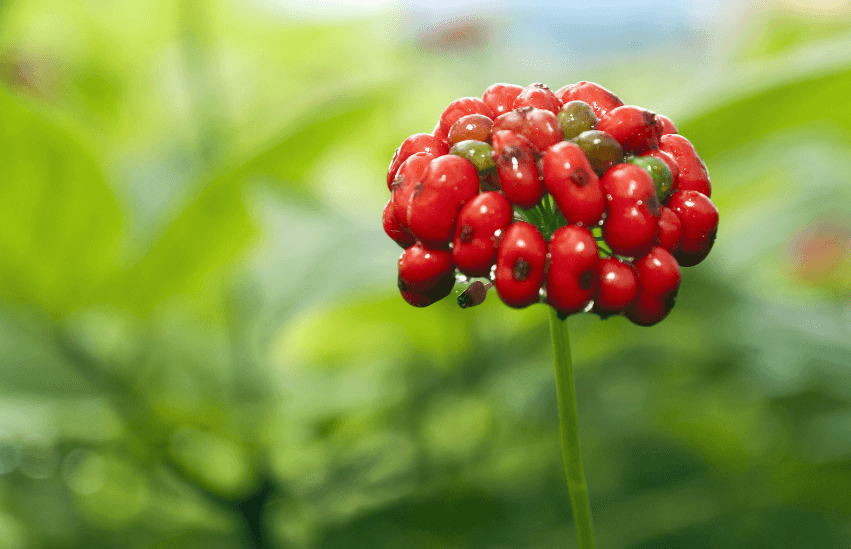
Common Name Ginseng,Asian ginseng, Chinese ginseng, Ginseng, Korean ginseng
Family Name Araliaceae
Parts Used Roots
Herbal Actions Adaptogenic, Immunomodulatory, Tonic, Stimulant, Antioxidant
Health Benefits Energy Boost, Cognitive Enhancement, Immune Support
What are the Benefits of Panax ginseng?
Panax ginseng, revered for centuries across Asia and in Traditional Chinese Medicine (TCM), is celebrated as a vital tonic for enhancing vitality and longevity.* Energetically, this herb is considered a yang toner that’s slightly warm in nature and sweet in taste. It is a cornerstone in TCM, commonly used to fortify the body's qi (vital energy), invigorate the spleen, and nourish the lungs.
Packed with ginsenosides, unique compounds found in ginseng, Panax ginseng acts as a powerful adaptogen that helps the body manage stress and maintain equilibrium. It also boasts impressive antioxidant properties that help combat oxidative stress and support the body’s immune system.* Recognized for its potential to boost cognitive function and physical stamina, Panax ginseng is often dubbed a “natural energizer.”
Its benefits extend beyond medicinal uses; Panax ginseng is also incorporated into everyday dietary practices. It’s commonly used in energy drinks, herbal teas, and traditional dishes that require a revitalizing boost, such as Korean ginseng chicken soup (samgyetang). This widespread use underscores its role in promoting not only physical endurance and mental clarity but also in enhancing the overall quality of life, making Panax ginseng a celebrated superfood in various cultural contexts.
Historical Use of Panax ginseng
Panax ginseng has been a profoundly important herb in the traditions and medicinal practices of various cultures, especially within Indigenous communities of East Asia, where it is native. Known as a symbol of health, vitality, and spiritual harmony, Panax ginseng has been integrated into spiritual ceremonies and rituals for centuries.
Historically, Panax ginseng was believed by many Asian Indigenous communities to house protective spirits. These communities used the roots of ginseng in sacred rituals intended to invoke health, longevity, and protection against negative influences. The powerful properties of ginseng were thought to strengthen both the physical body and the spirit, making it a crucial element in rites that sought to harmonize the flow of vital energy within and around individuals.
According to traditional beliefs, consuming ginseng could restore balance, enhance strength, and promote healing. It was often used by healers and shamans in ceremonies to fortify one’s spiritual energy before significant events or in healing practices to assist with recovery from illness. The roots were sometimes carried as talismans or amulets to protect individuals from evil spirits and misfortune, echoing the beliefs of the Iroquois regarding wild cherry bark.
In addition to its spiritual uses, Panax ginseng was highly valued for its myriad health benefits and was often a key ingredient in traditional medicinal formulas. It was used to improve stamina, combat fatigue, increase mental clarity, and boost the immune system, thereby improving overall well-being.
This historical usage of Panax ginseng highlights its significant role not only in promoting physical wellness but also in enriching the cultural and spiritual practices of the communities that held it in high esteem, illustrating a deep reverence for this powerful plant that transcends mere physical health benefits.
Botanical Description & Habitat
Panax ginseng, also known as Asian ginseng, is a perennial plant native to the mountainous forests of East Asia. It grows slowly, with mature plants typically reaching a height of 30 to 60 centimeters. The plant features a single stem that grows from a fleshy root, often resembling the human body, with a parsnip-like shape that is distinctly forked.
The leaves of Panax ginseng are compound and grow in a whorl around the stem; each whorl usually consists of five or more leaflets that are long, oval, and finely toothed. The plant flowers in the summer, producing small, greenish-yellow flowers grouped in an umbrella-shaped cluster. The fruit of the ginseng plant is a bright red berry, usually containing two seeds, which ripens in the late summer or early autumn.
Panax ginseng prefers cool, shaded environments typical of mountainous deciduous forests. It thrives in well-drained, humus-rich soils that are moist but not waterlogged. The ideal habitat is under the canopy of hardwood trees, where the plant can receive filtered sunlight. Ginseng is highly sensitive to its environment and requires specific conditions for optimal growth, making it a challenging plant to cultivate.
Due to its specific growth requirements and the high value of the roots, Panax ginseng is often cultivated in ginseng farms, which mimic its natural habitat. These farms are typically found in regions such as northeastern China, Korea, and parts of Russia and Japan. Overharvesting and habitat loss have made wild ginseng rare and much more expensive than the cultivated varieties.
The plant’s sensitivity to its environment, combined with its slow growth rate (taking up to five or more years to mature), contributes to its rarity and high value in traditional medicine markets, where it is sought for its wide range of health benefits.

